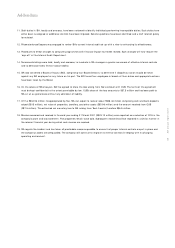Singapore Airlines 2001 Annual Report Download - page 51
Download and view the complete annual report
Please find page 51 of the 2001 Singapore Airlines annual report below. You can navigate through the pages in the report by either clicking on the pages listed below, or by using the keyword search tool below to find specific information within the annual report.
49 SIA annual report 00/01
Management of Financial Risks
Overview
The Company operates in 38 countries and generates revenue in various local currencies. The Company’s airline operations carry certain
financial and commodity risks, including the effects of changes in jet fuel prices, foreign currency exchange rates, interest rates and the
market value of its investments. The Company’s overall risk management approach is to minimise the effects of such volatility on its
financial performance.
Financial risk management policies are periodically reviewed and approved by the Board Finance Committee (" BFC" ).
Jet Fuel Price Risk
The Company’s earnings are affected by changes in the price of jet fuel. The Company manages this risk by using swap and option
contracts up to 24 months forward. A change in price of one US cent per American gallon affects the Company’s annual fuel costs by
S$21 million, before accounting for US Dollar exchange rate movements and changes in volume of fuel consumed.
As at 31 March 2001, the Company has hedged about 39% of the fuel requirement projected for FY2001-02 and about 10% of that
for FY2002-03.
Foreign Currency Risk
The Company is exposed to the effects of foreign exchange rate fluctuations because of its foreign currency denominated operating
revenues and expenses. These account for 71.8% of total revenue and 48.0% of total operating expenses. The Company’s largest
exposures are from the US Dollar (" USD" ), British Pound, Japanese Yen, Euro, Australian Dollar, Hong Kong Dollar, Taiwan Dollar, Indian
Rupee, Chinese Renminbi, Korean Won, New Zealand Dollar, Swiss Franc and Malaysian Ringgit. The Company generates a surplus in all
of these currencies, except for the USD. The Company also has a deficit in Singapore Dollar (" SGD" ). The deficits in USD are
attributable to capital expenditure, leasing costs and fuel costs – all conventionally denominated and payable in USD. The deficit in SGD
is due to home base expenditures which are payable in SGD.
The Company manages its foreign exchange exposure by a policy of matching, as far as possible, receipts and payments in each
individual currency. Surpluses of convertible currencies are sold, as soon as practicable, for USD and SGD. The Company also uses
forward foreign currency contracts to hedge a portion of its future foreign exchange exposure.
Interest Rate Risk
The Company’s earnings are also affected by changes in interest rates due to the impact such changes have on interest income from
cash, short-term deposits and interest-bearing financial assets.
The Company’s cash, short-term deposits and interest-bearing financial assets are predominantly denominated in Singapore Dollar and
US Dollar.
























